Got a boring fence that's just sitting there doing nothing? Time to turn that wasted space into your garden's best feature! Whether you're working with a tiny backyard or a sprawling property, raised beds along your fence line can completely transform your outdoor space. We're talking everything from sleek metal designs that'll make your neighbors jealous to rustic cedar planks that scream cozy cottage vibes. Plus, you'll discover clever tricks like built-in seating, rain catchment systems, and vertical growing solutions that maximize every square inch. Ready to make that fence work harder than ever?
1. Cedar Plank Raised Garden Bed Along Fence Design
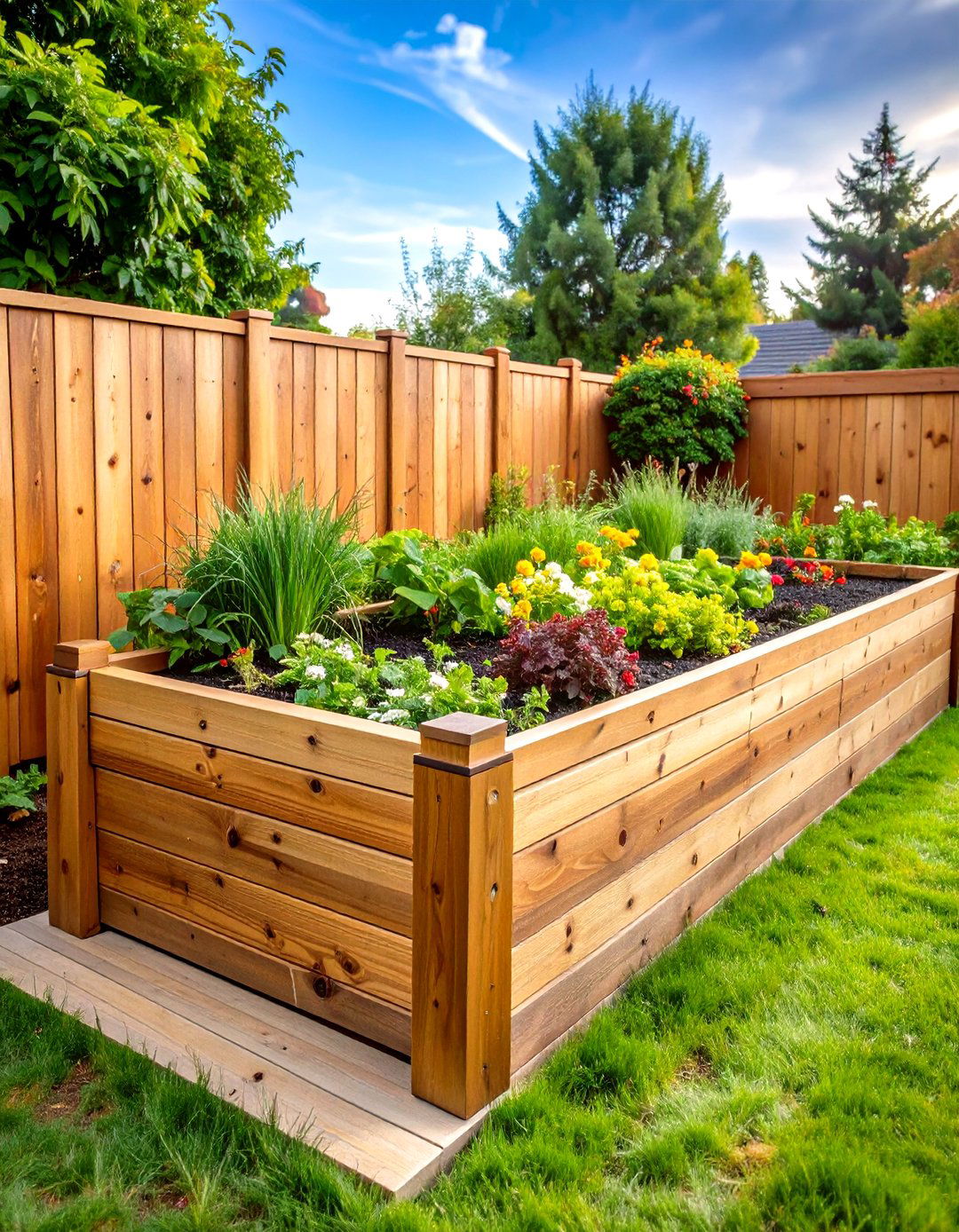
This classic raised garden bed along fence design uses cedar fence planks stacked two boards high, creating a 12-inch deep growing space perfect for vegetables and herbs. The natural rot-resistant properties of cedar make it ideal for long-term garden use without chemical treatments. Corner posts provide structural support while maintaining the rustic aesthetic that complements most fence styles. The 3-foot width allows easy access from one side, making it practical for narrow spaces between fences and walkways. Installation involves basic carpentry skills, using deck screws and ensuring proper drainage with a gravel base layer. This design typically costs under $25 per 6-foot section, making it budget-friendly for extended fence lines. The cedar's natural oils repel insects while weathering to an attractive silver-gray color over time.
2. Tiered Raised Garden Bed Along Fence System

Create visual interest and maximize growing space with this tiered raised garden bed along fence arrangement featuring multiple levels ascending from 8 inches to 18 inches high. The cascading design allows for strategic plant placement, with taller crops in the back tier and shorter ones in front. This system works exceptionally well for herb gardens, allowing easy access to frequently used plants while creating a lush, layered appearance. The varying heights provide different soil depths suitable for various root systems, from shallow lettuce to deep-rooted tomatoes. Construction uses pressure-treated lumber with landscape fabric lining to prevent soil migration between levels. The tiered structure also improves drainage and air circulation around plants. This design transforms plain fence lines into dynamic garden features that serve as both functional growing spaces and attractive landscape elements.
3. Modern Metal Raised Garden Bed Along Fence Installation

Contemporary galvanized steel raised garden beds along fences offer sleek, industrial aesthetics combined with exceptional durability and heat retention benefits. The corrugated metal sides reflect heat, extending growing seasons and protecting plants from temperature fluctuations. These modular systems typically stand 12-17 inches high and can be customized to any fence length using connector pieces. The metal construction eliminates concerns about rot, pest damage, or chemical leaching associated with treated wood. Installation requires minimal tools and can be completed in hours rather than days. The silver finish complements modern fence styles while the clean lines create sophisticated garden spaces. These beds warm soil faster in spring and maintain heat longer in fall, making them ideal for cool-climate gardening. The smooth surfaces are easy to clean and maintain, requiring only occasional hosing to remove soil buildup.
4. Stone Block Raised Garden Bed Along Fence Structure
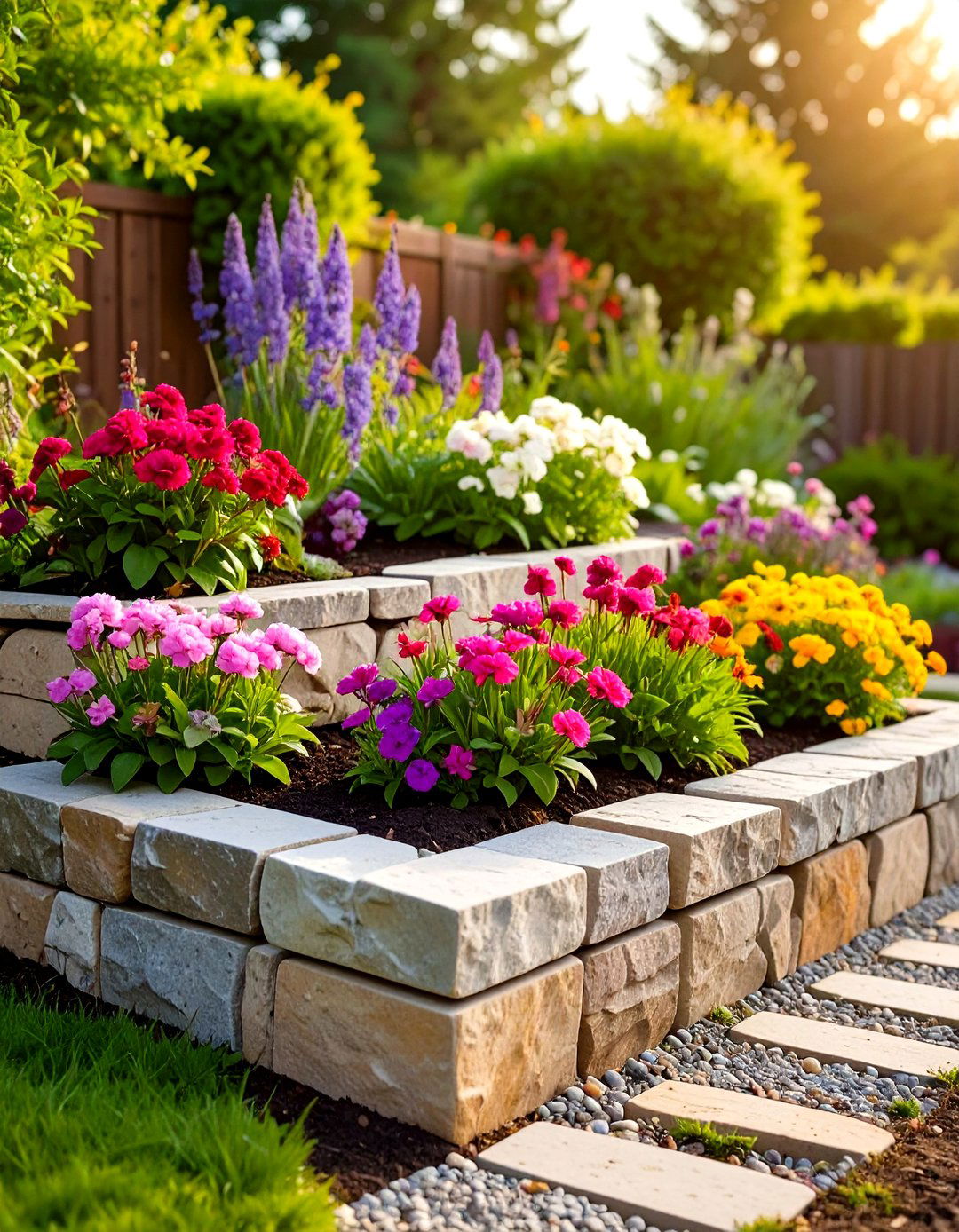
Natural stone blocks create permanent, attractive raised garden beds along fences that blend seamlessly with landscape hardscaping. These substantial structures typically use limestone, sandstone, or concrete blocks stacked 12-24 inches high without mortar for drainage and flexibility. The thermal mass of stone moderates soil temperature, protecting roots from extreme heat and cold. This design works particularly well with stone or brick fences, creating cohesive landscape elements. The weight and stability of stone blocks eliminate the need for additional support structures, while the natural materials age gracefully over decades. Installation involves careful leveling and proper drainage preparation, but results in virtually maintenance-free garden beds. The irregular textures and natural colors of stone provide beautiful contrast against fence materials while creating habitat for beneficial insects and small wildlife.
5. Curved Raised Garden Bed Along Fence Layout

Soften harsh fence lines with gracefully curved raised garden beds that create organic, flowing garden spaces rather than rigid rectangular plots. These serpentine designs use flexible materials like bendable metal edging or carefully cut wooden boards to achieve smooth curves. The undulating bed edges add visual interest while maximizing planting area within given fence lengths. This approach works exceptionally well for ornamental gardens featuring flowing grasses, perennials, and trailing plants that complement the curved design. The varied bed widths create opportunities for diverse plant groupings and naturalistic layouts. Construction requires more planning than straight beds but results in sophisticated garden features that appear professionally designed. The curved edges also provide better access to plants and create natural walking paths along the fence line.
6. Vertical Trellis Raised Garden Bed Along Fence Design
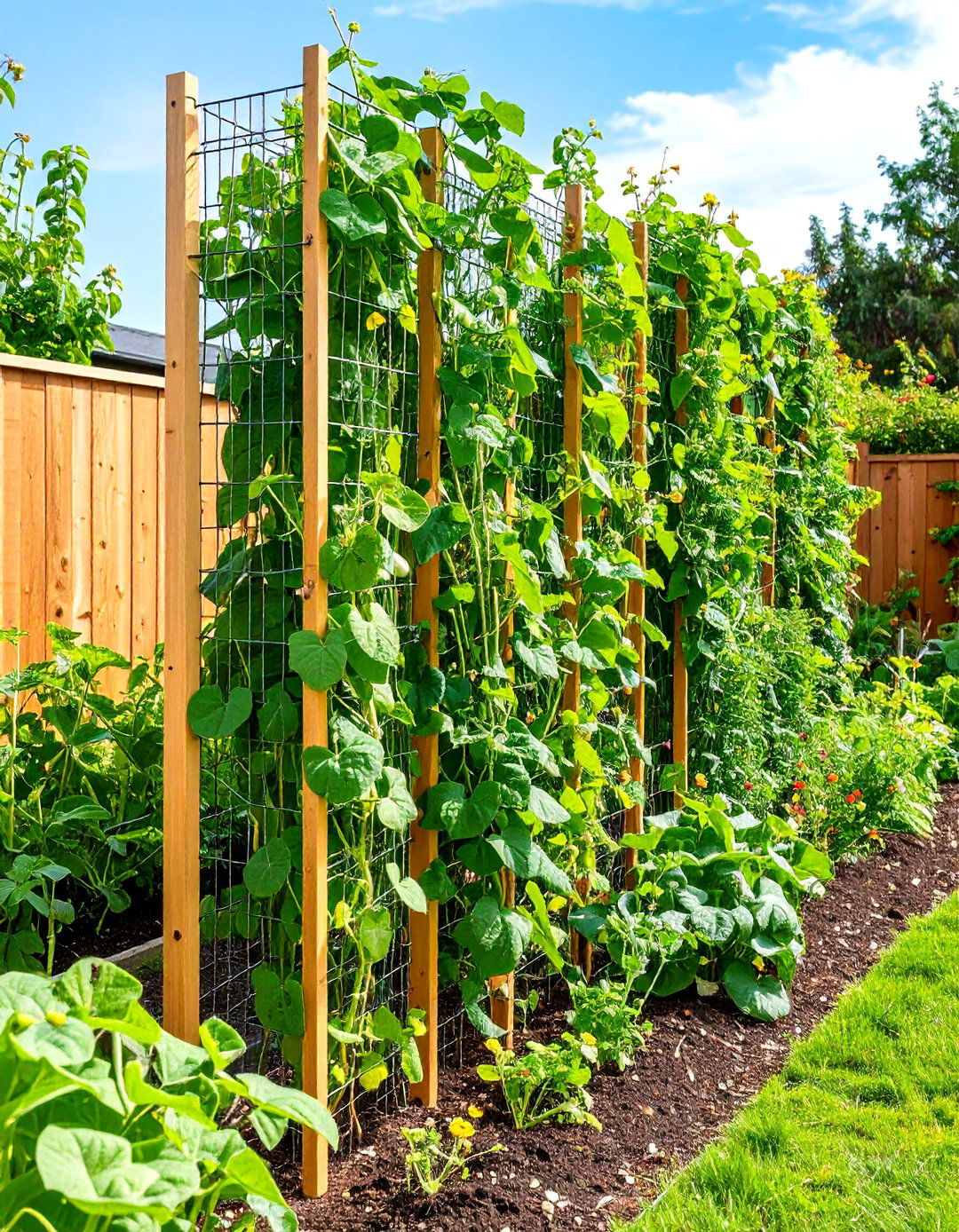
Maximize growing space with vertical trellis systems integrated into raised garden beds along fences, perfect for climbing vegetables like beans, peas, and cucumbers. The bed structure incorporates built-in support posts that extend 6-8 feet above ground level, supporting wire mesh or wooden lattice panels. This design effectively doubles or triples growing capacity within limited ground space while creating attractive living walls. The vertical elements provide privacy screening while producing food, making efficient use of narrow side yards or small gardens. Plants grown vertically receive better air circulation and sunlight exposure, reducing disease problems common in ground-level gardens. The trellis system can be customized with removable panels for easy access and seasonal crop rotation. This approach transforms ordinary fence lines into productive vertical farms that yield impressive harvests from minimal ground area.
7. Privacy Screen Raised Garden Bed Along Fence Combination
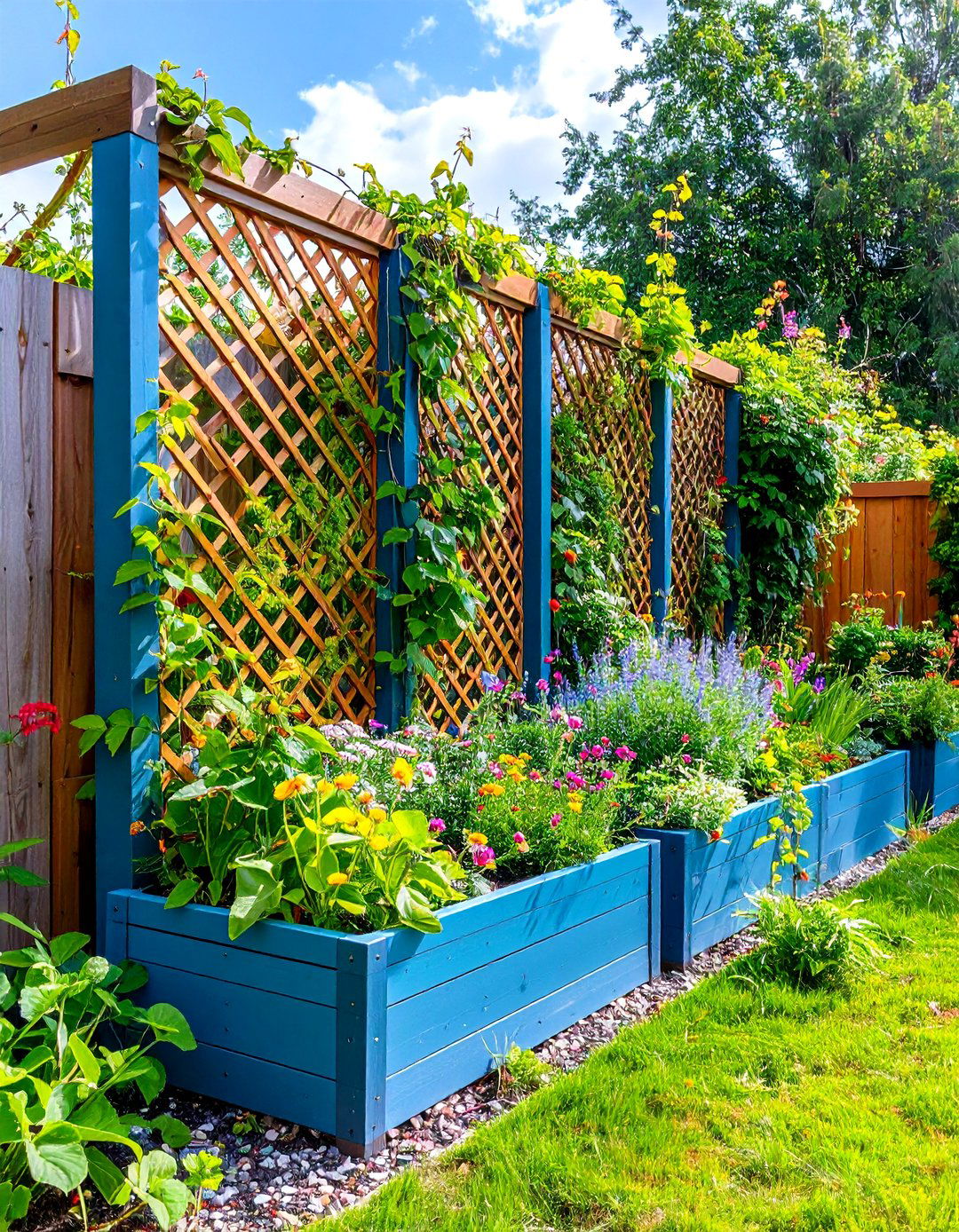
Combine functionality with privacy using raised garden beds along fences that incorporate screening elements to create secluded garden spaces. These designs feature planter boxes topped with lattice panels, bamboo screens, or cedar slat fencing that extends 3-6 feet above the bed height. The dual-purpose structure provides growing space while blocking unwanted views or creating intimate garden rooms. The planters can be filled with climbing plants that eventually cover the screening material, creating living privacy walls. This design works particularly well for urban gardens where privacy is essential but space is limited. The integrated approach eliminates the need for separate privacy installations while adding productive growing areas. Multiple units can be linked together to create longer privacy runs while maintaining consistent garden aesthetics.
8. Herb Spiral Raised Garden Bed Along Fence Adaptation
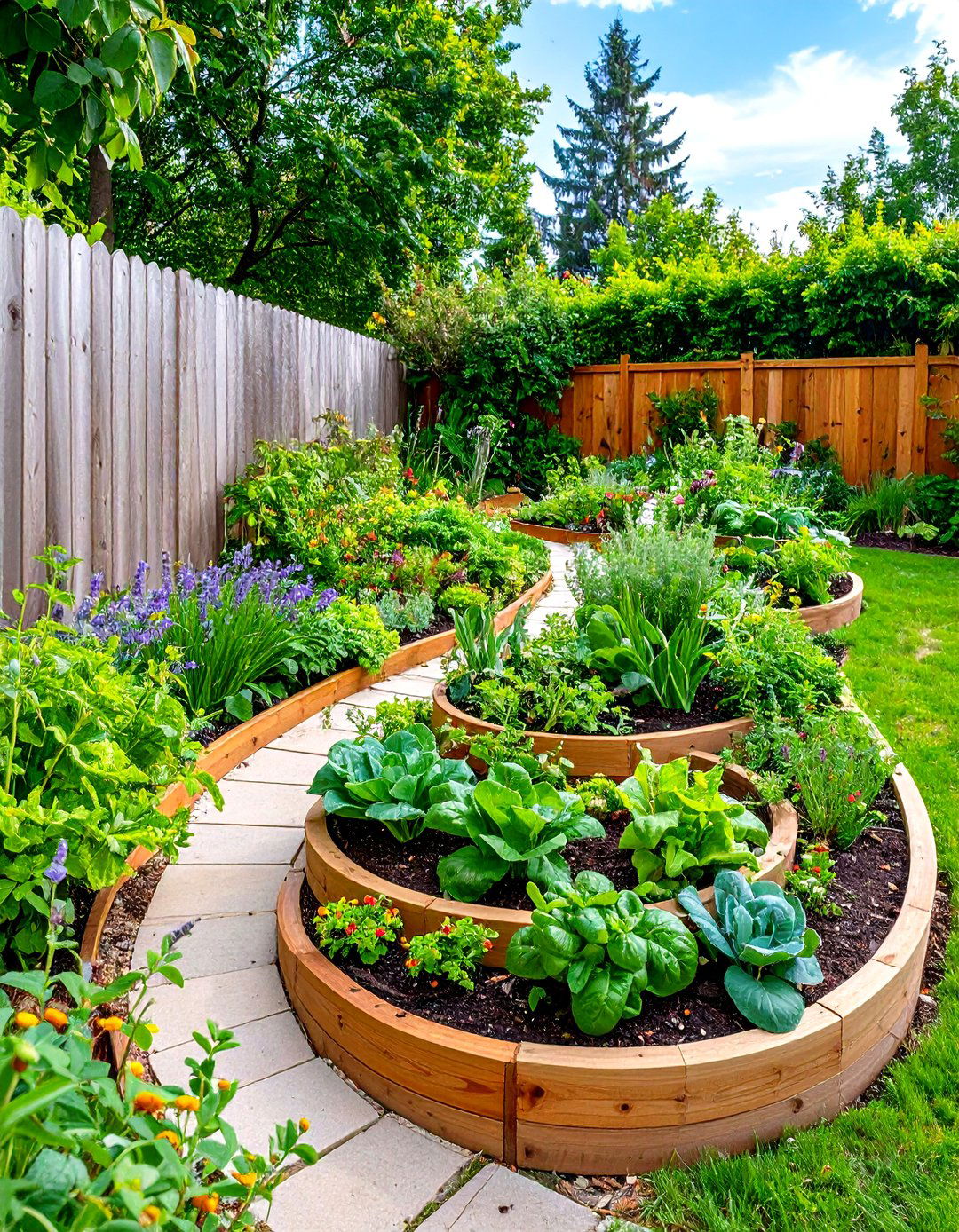
Adapt the traditional herb spiral concept for fence-adjacent installation, creating a raised garden bed along fence that maximizes herb growing in minimal space. This design features a spiral-shaped bed that rises from 6 inches at the outer edge to 18 inches at the center, creating diverse microclimates for different herbs. Mediterranean herbs like rosemary and thyme thrive in the well-drained upper levels, while moisture-loving herbs like mint and parsley flourish in the lower, moister areas. The spiral design allows easy access to all plants while creating an attractive architectural feature against fence backgrounds. Construction uses stone, brick, or curved wooden boards to create the spiral retaining walls. This space-efficient design can accommodate 20-30 different herbs in a 6-foot diameter area, providing fresh seasonings year-round while creating a beautiful focal point.
9. Container Fusion Raised Garden Bed Along Fence System
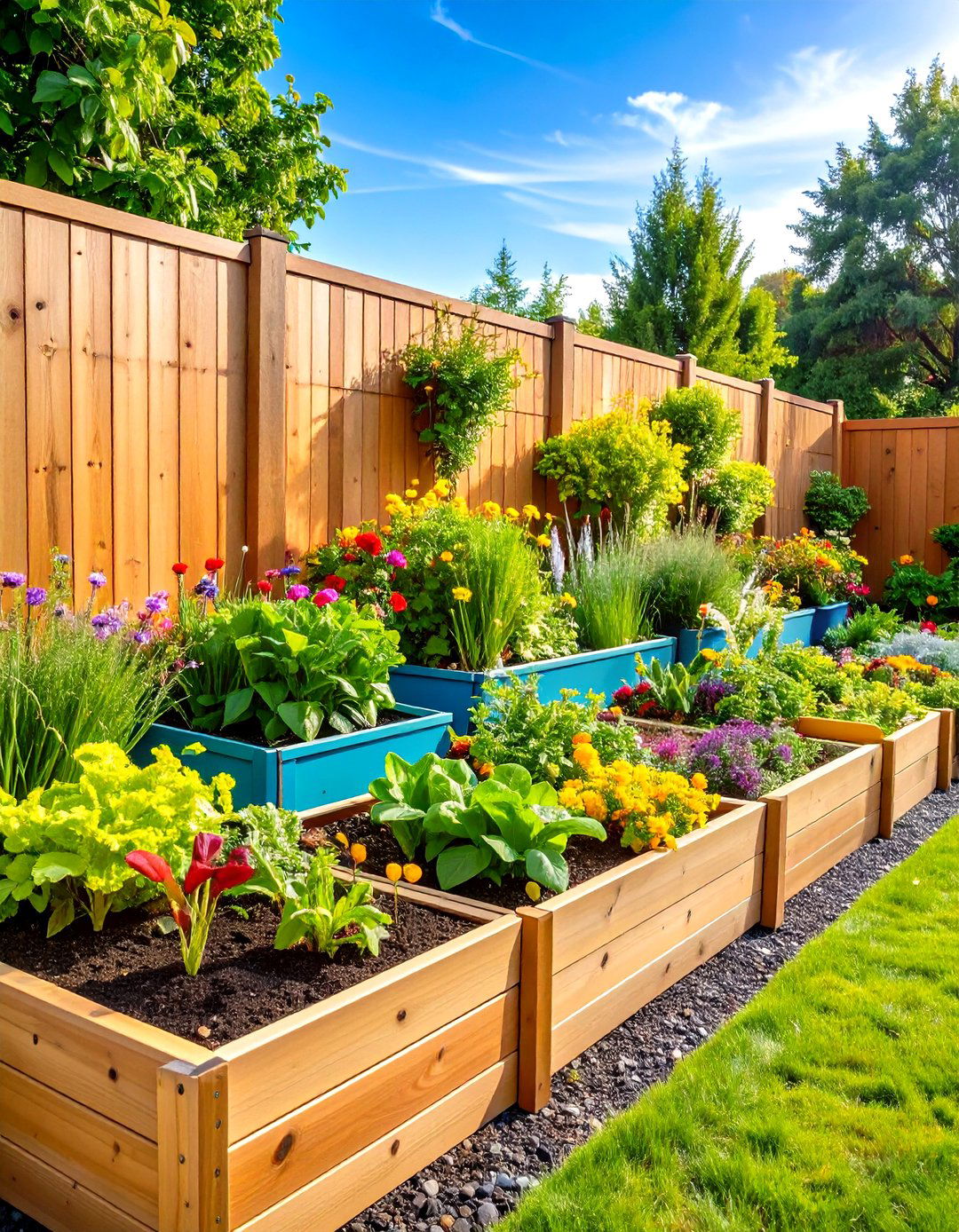
Blend raised bed gardening with container flexibility using a hybrid system that combines permanent raised garden beds along fences with strategically placed containers. The fixed beds provide stable growing areas for larger plants and perennials, while moveable containers allow for seasonal changes and crop rotation. This approach offers design flexibility and the ability to optimize growing conditions for specific plants. Containers can be elevated on platforms or stands to create varied heights and visual interest. The system works particularly well for experimental gardening and testing new plant varieties before committing to permanent bed space. Different container materials and sizes create textural variety while maintaining cohesive design through consistent plant selections and color schemes. The combination approach maximizes growing space while providing options for seasonal garden transformations.
10. Rustic Log Raised Garden Bed Along Fence Construction
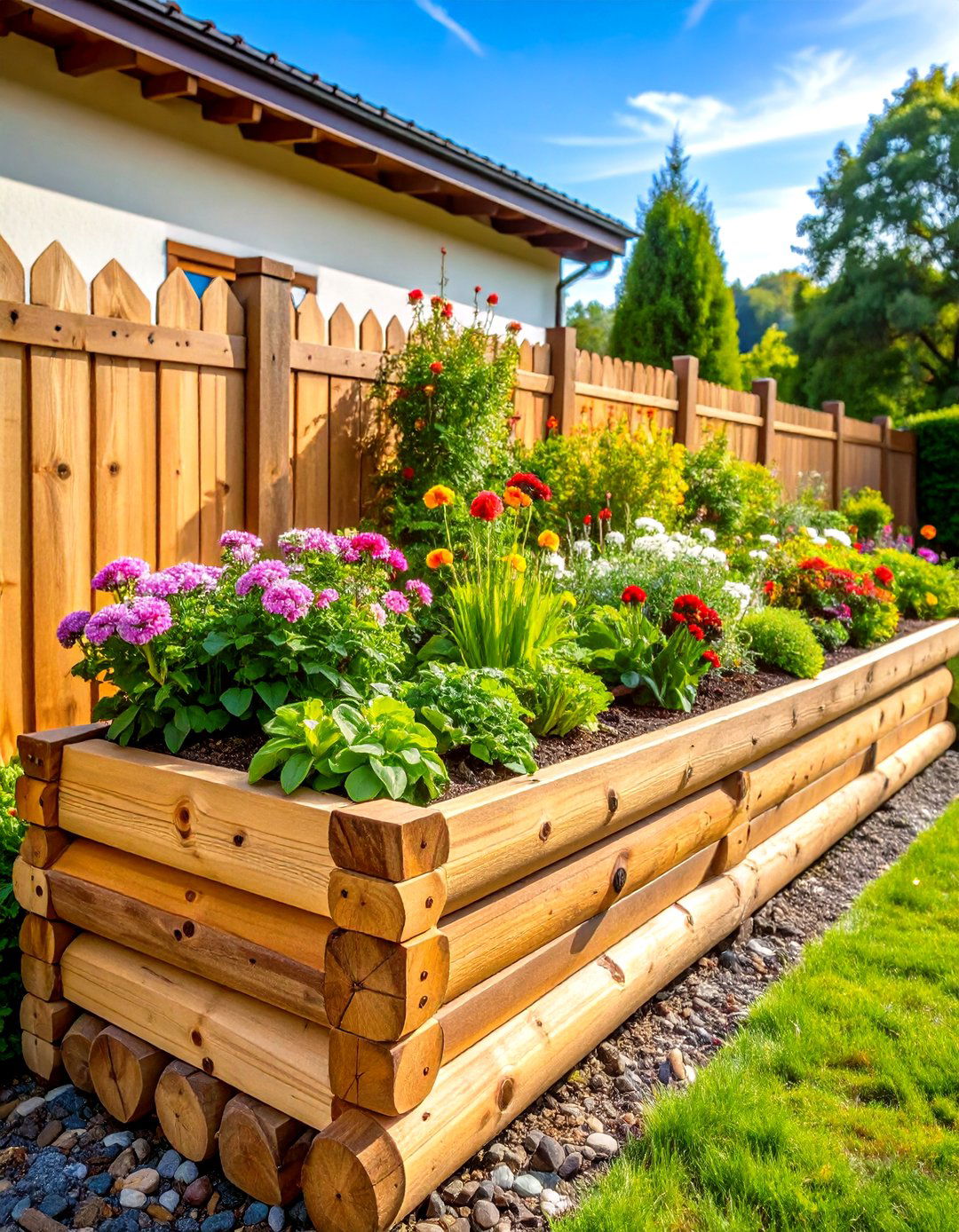
Create charming, natural-looking raised garden beds along fences using whole logs or log slabs that complement rustic fence styles and country garden aesthetics. These beds typically use cedar, oak, or other rot-resistant logs stacked horizontally to create 12-24 inch high growing spaces. The natural materials blend seamlessly with wooded landscapes while providing excellent insulation for plant roots. Log beds can be chinked with smaller wood pieces or left with gaps for drainage and air circulation. This design works particularly well for cottage gardens, farmhouse landscapes, and natural settings where processed lumber would appear out of place. The logs provide habitat for beneficial insects and small wildlife while aging gracefully over many years. Construction requires basic woodworking skills and proper log preparation to ensure longevity and structural integrity.
11. Raised Garden Bed Along Fence with Integrated Seating
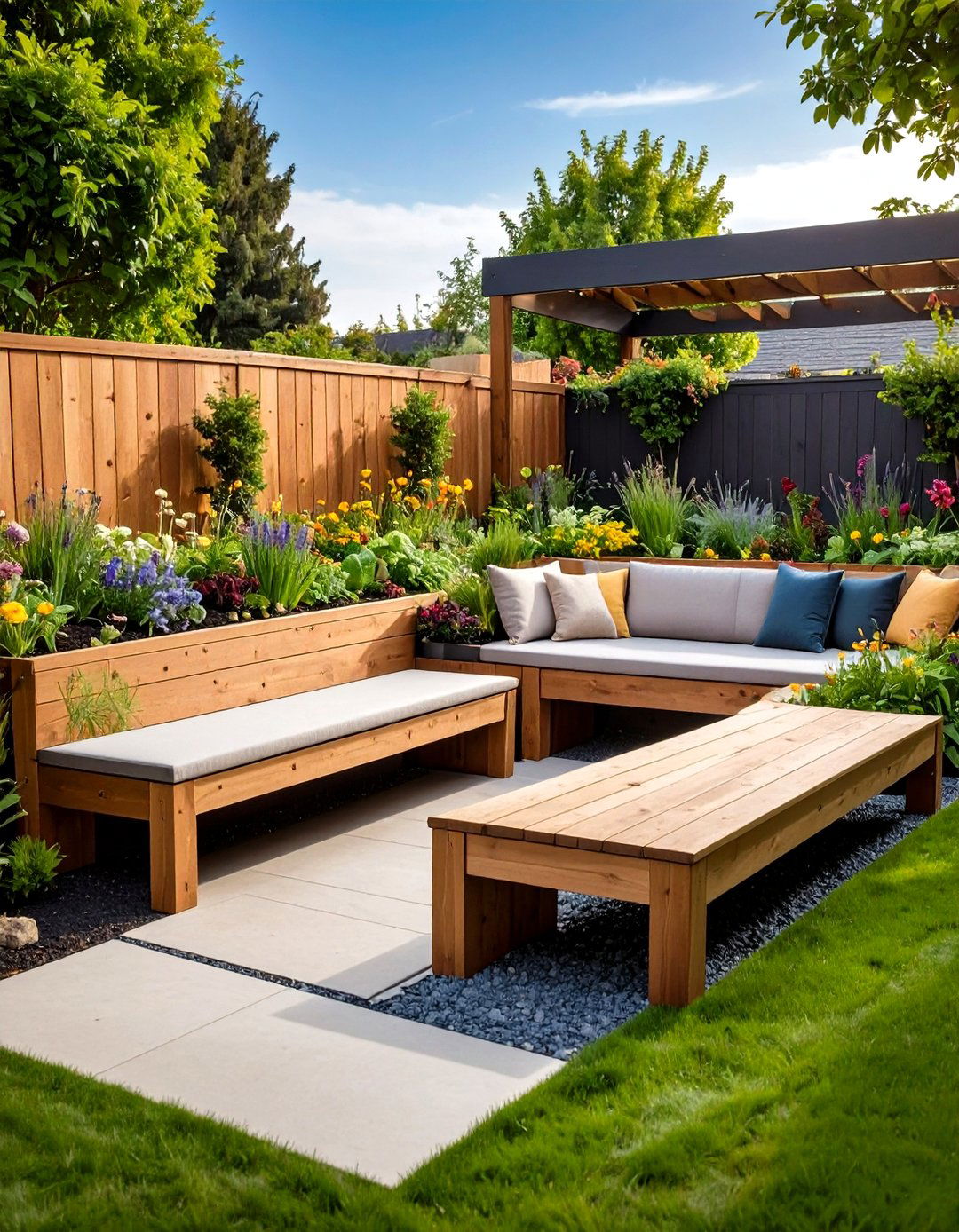
Combine gardening functionality with comfortable seating by designing raised garden beds along fences with built-in bench features. The bed walls are constructed 16-18 inches high with 12-16 inch wide tops that serve as garden benches for maintenance, harvesting, and relaxation. This dual-purpose design maximizes space efficiency while creating inviting garden areas perfect for morning coffee or evening reflection. The bench surfaces can be topped with weather-resistant materials like cedar decking or composite lumber for comfort and durability. This approach works exceptionally well in small urban gardens where every square foot must serve multiple functions. The integrated seating encourages garden interaction and maintenance while providing strategic rest points during garden work. The bench height also creates ideal ergonomic conditions for planting and harvesting activities.
12. Galvanized Steel Raised Garden Bed Along Fence Installation

Industrial-strength galvanized steel raised garden beds along fences offer exceptional durability and modern aesthetics that complement contemporary fence designs. These beds feature corrugated steel sides with aluminum or steel corner posts, creating clean lines and lasting structures. The metal construction provides excellent heat retention, extending growing seasons and protecting plants from temperature fluctuations. The smooth surfaces resist pest damage and require minimal maintenance beyond occasional cleaning. These beds typically stand 12-17 inches high and can be customized to any length using modular components. The galvanized coating prevents rust and corrosion, ensuring decades of service life. Installation requires basic tools and can be completed quickly with pre-cut materials. The neutral steel finish complements various fence materials while creating sophisticated garden spaces that appeal to modern design sensibilities.
13. Brick Raised Garden Bed Along Fence Design

Classic brick construction creates permanent, attractive raised garden beds along fences that provide thermal mass benefits and timeless appeal. These beds typically use standard building bricks stacked 12-18 inches high in running bond patterns for structural stability. The thermal mass of brick moderates soil temperature, protecting plants from extreme weather while extending growing seasons. This design works particularly well with brick or masonry fences, creating cohesive landscape elements. The porous nature of brick allows for excellent drainage while the substantial construction provides decades of service life. Installation requires basic masonry skills and proper foundation preparation but results in virtually maintenance-free garden structures. The warm colors and textures of brick complement various garden styles while aging gracefully over time. These beds can be built without mortar for easier modification or constructed with mortar for permanent installation.
14. Composite Lumber Raised Garden Bed Along Fence System
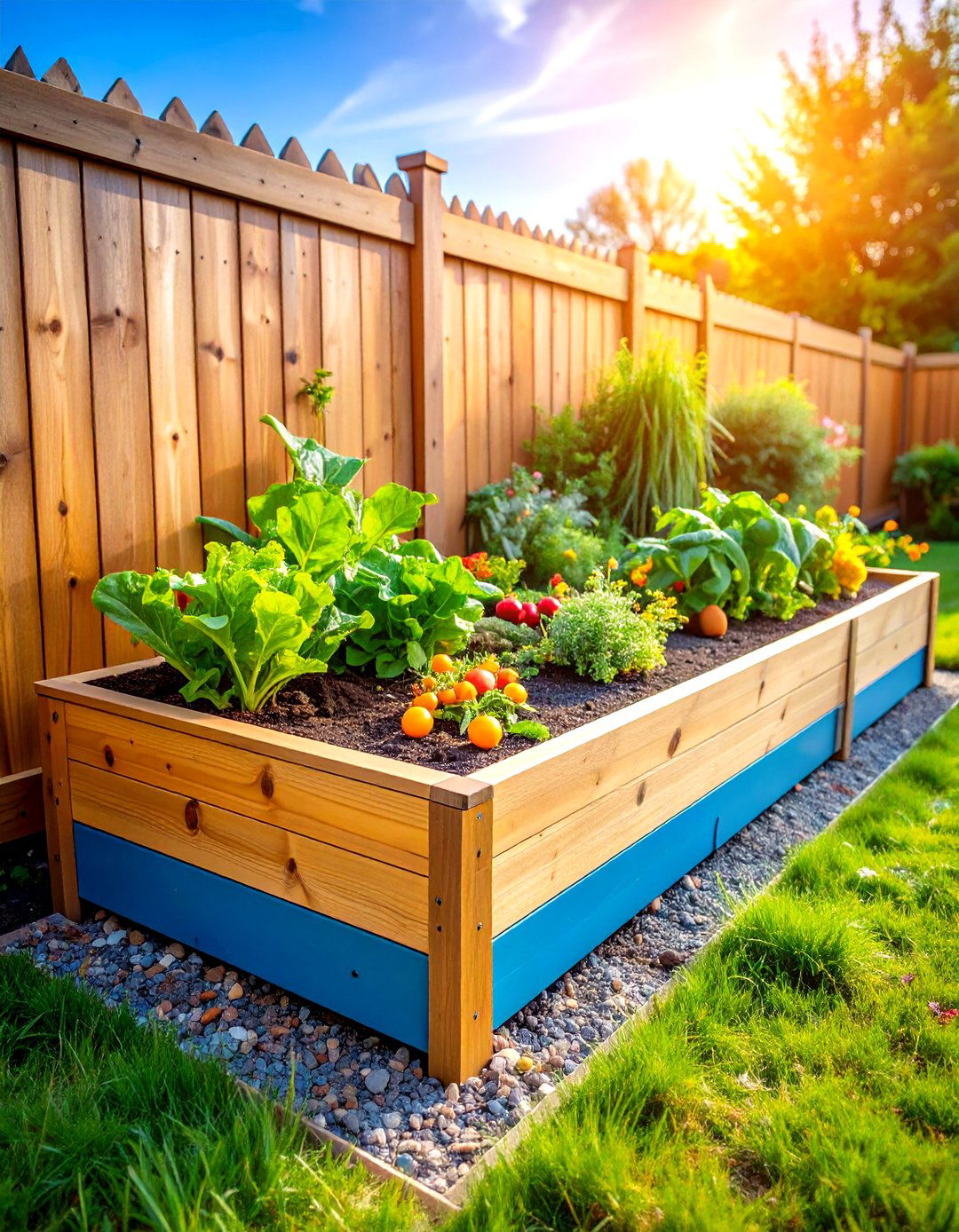
Eco-friendly composite lumber raised garden beds along fences combine the appearance of wood with the durability of synthetic materials, creating low-maintenance garden structures. These beds resist rot, insects, and weather damage while maintaining consistent appearance over many years. The composite materials are available in various wood-tone colors and textures that complement different fence styles. Unlike natural wood, composite lumber doesn't require staining, sealing, or replacement, making it ideal for busy gardeners. The material is safe for food production and doesn't leach chemicals into soil. Installation follows standard woodworking practices with the added benefit of dimensional stability and resistance to warping. While initial costs are higher than natural wood, the long-term value and reduced maintenance make composite lumber an excellent investment for permanent garden installations.
15. Keyhole Raised Garden Bed Along Fence Adaptation

Adapt the efficient keyhole garden concept for fence-adjacent installation, creating a raised garden bed along fence that maximizes productivity through integrated composting. This design features a horseshoe-shaped bed with a central compost column that feeds nutrients directly to surrounding plants. The bed typically measures 6-8 feet across with 18-24 inch high walls containing the growing medium. The central access path allows easy reach to all plants while the compost core provides continuous nutrition throughout the growing season. This design works exceptionally well for small spaces where intensive production is desired. The integrated composting system reduces waste while improving soil fertility. Construction uses standard bed materials with a wire mesh or perforated pipe compost column. The keyhole design produces remarkable yields from limited space while creating attractive, productive garden features.
16. Multi-Level Raised Garden Bed Along Fence Platform
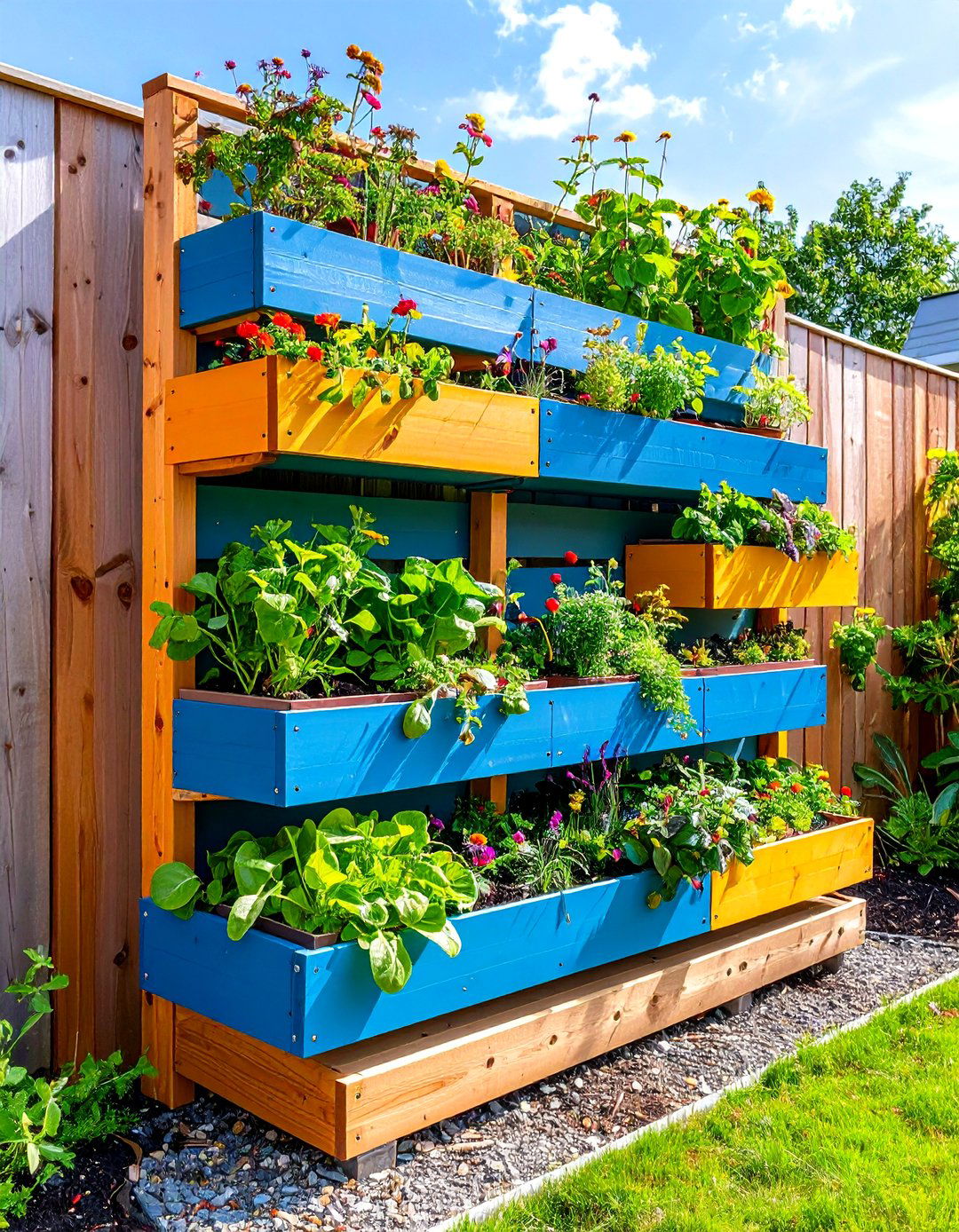
Create impressive vertical growing systems with multi-level raised garden bed platforms along fences that provide diverse growing environments at different heights. These stepped designs feature 2-4 different levels ranging from 12-36 inches high, allowing for strategic crop placement and improved garden management. The varying heights create opportunities for different plant types while improving drainage and air circulation. Upper levels work well for herbs and small vegetables, while lower levels accommodate larger plants and root crops. The platform design also provides storage opportunities beneath raised sections for tools and supplies. This system works particularly well for accessibility, allowing gardeners to work at comfortable heights. The multi-level approach creates dramatic visual impact while maximizing growing space within limited ground area. Construction requires careful planning but results in highly functional and attractive garden features.
17. Woven Willow Raised Garden Bed Along Fence Style
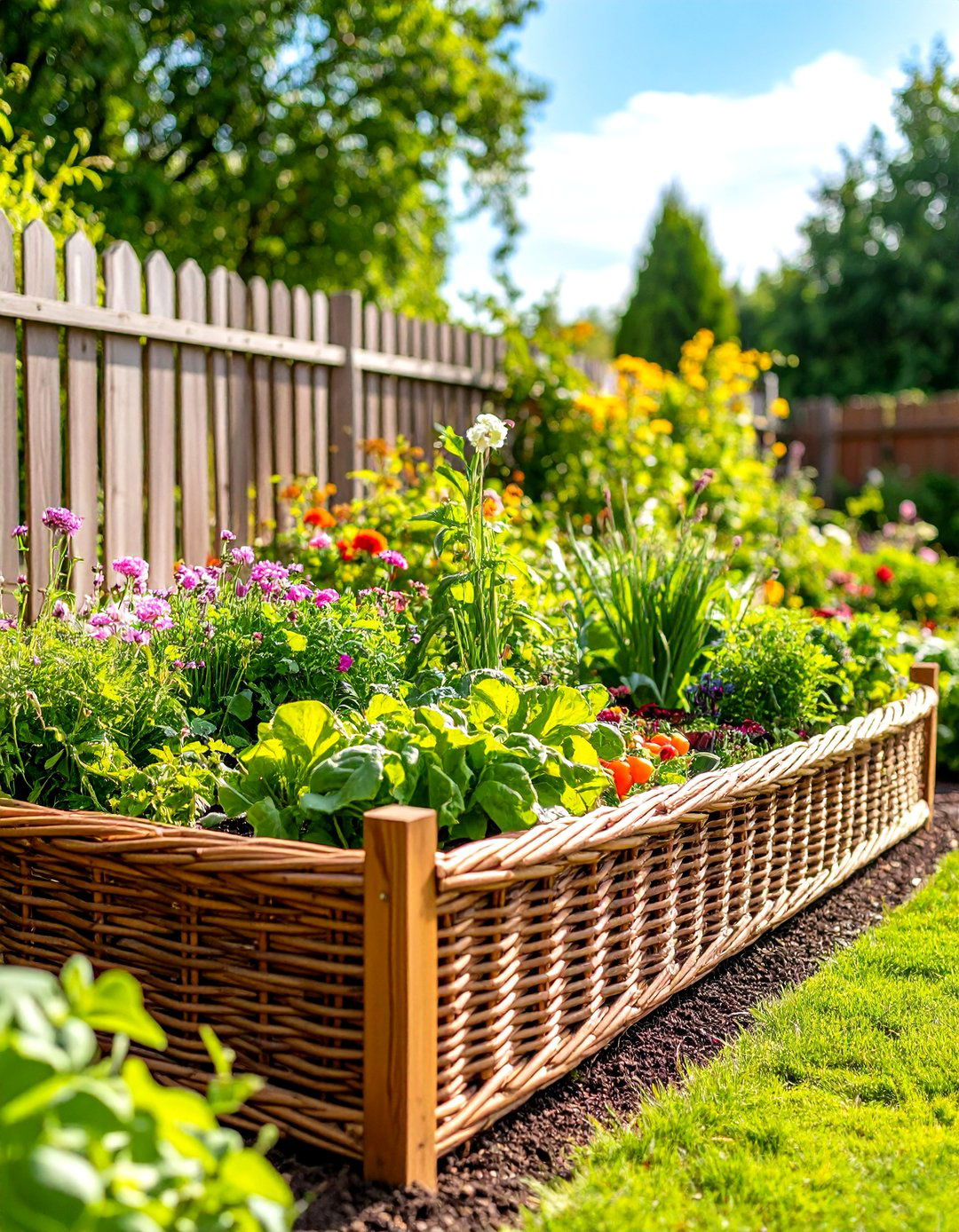
Natural woven willow raised garden beds along fences create charming, cottage-garden aesthetics while providing excellent growing conditions for herbs and vegetables. These beds feature traditional basket-weaving techniques using flexible willow branches woven between wooden stakes to create attractive, permeable walls. The natural materials blend seamlessly with rustic fence styles while providing excellent drainage and air circulation. The woven construction allows for easy root pruning and soil amendment access. This design works particularly well for organic gardens and natural landscapes where processed materials would appear out of place. The willow gradually breaks down over 3-5 years, adding organic matter to the soil while the structure can be easily renewed. Installation requires basic weaving skills and seasonal willow harvest or purchase. The natural appearance and sustainability of willow make it an excellent choice for eco-conscious gardeners.
18. Concrete Block Raised Garden Bed Along Fence Construction
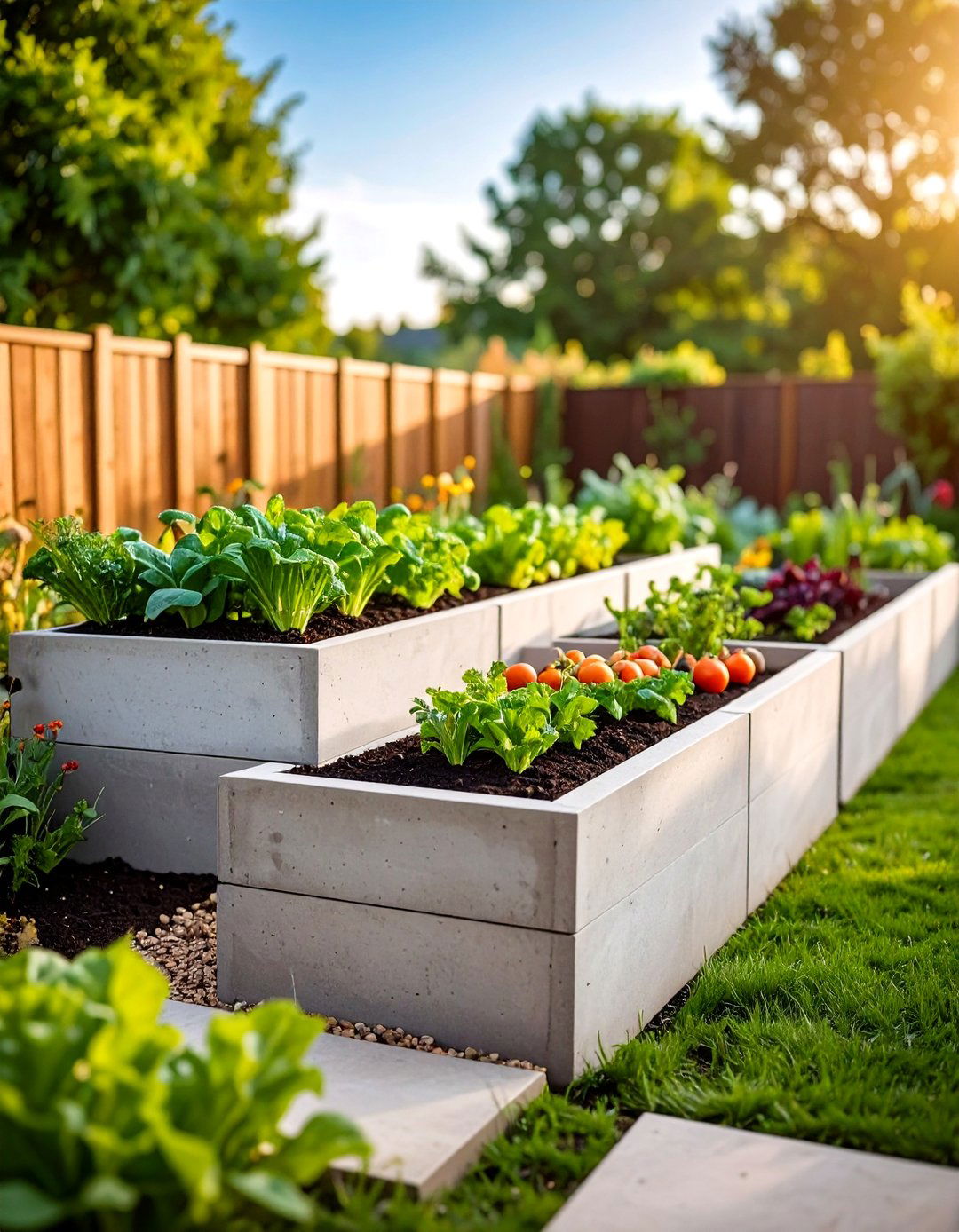
Durable concrete block raised garden beds along fences provide permanent, low-maintenance growing structures that complement modern fence designs. These beds typically use standard concrete masonry units (CMUs) stacked 12-24 inches high with or without mortar depending on desired permanency. The hollow blocks can be filled with soil for additional growing space or left empty for improved drainage. The thermal mass of concrete moderates soil temperature while the porous material allows for excellent drainage. This design works particularly well for desert climates and areas with challenging soil conditions. The blocks can be stained or painted to match fence colors and landscape themes. Installation requires basic masonry skills and proper foundation preparation. The substantial construction provides decades of service life while creating clean, geometric garden lines that appeal to contemporary design sensibilities.
19. Raised Garden Bed Along Fence with Rain Catchment
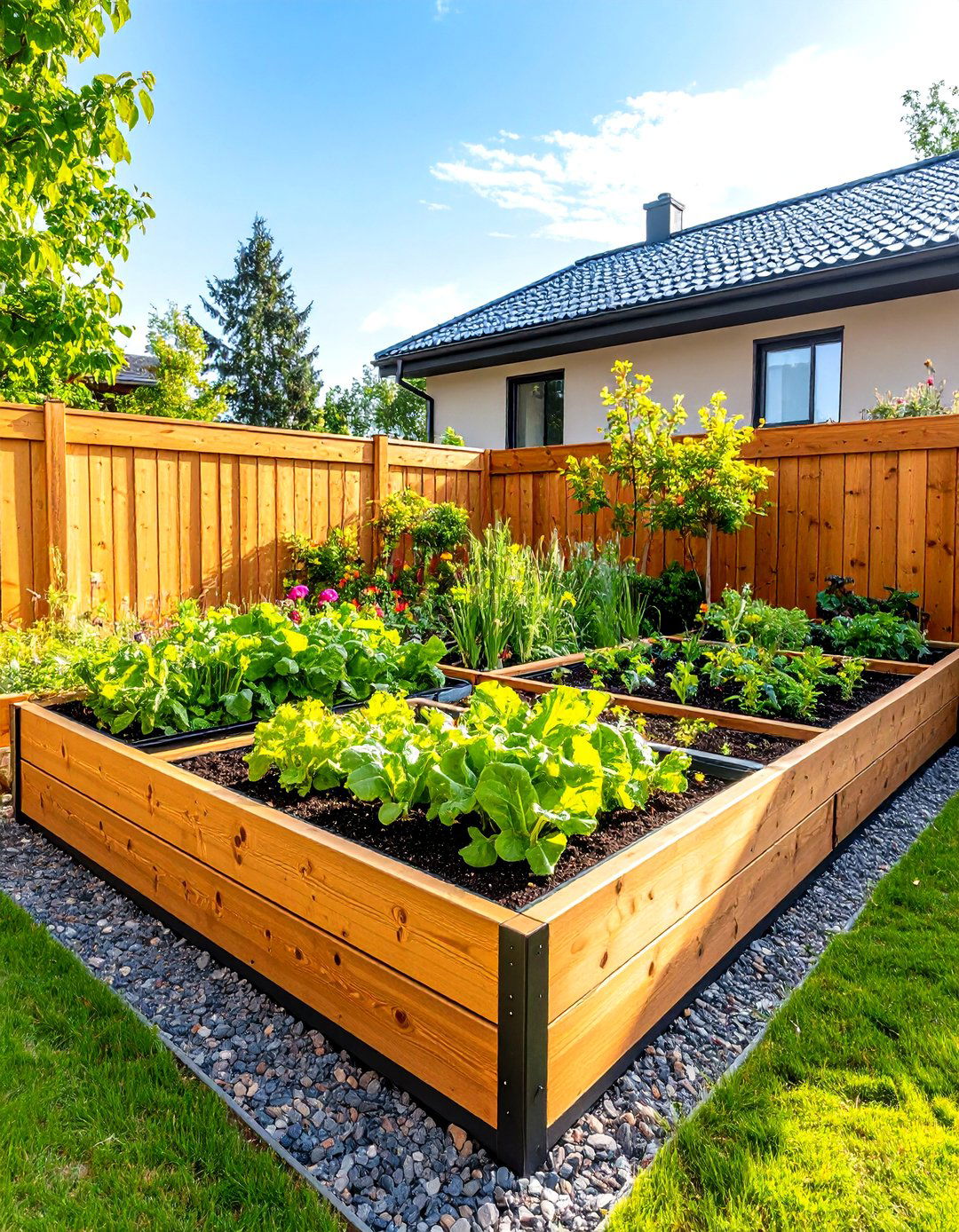
Integrate sustainable water management with raised garden beds along fences by incorporating rain catchment systems that collect and store moisture for garden use. These designs feature slightly sloped bed surfaces that direct rainwater toward collection points or built-in reservoirs within the bed structure. The system can include simple gutters along fence lines that channel water into garden beds or more sophisticated cistern systems for dry-season use. This approach reduces water consumption while providing consistent moisture for plants. The integrated design eliminates the need for separate irrigation systems while creating self-sustaining garden environments. Construction involves proper grading and drainage planning to ensure effective water collection without creating waterlogged conditions. The sustainable approach appeals to environmentally conscious gardeners while reducing maintenance requirements and water costs.
20. Elevated Table-Style Raised Garden Bed Along Fence Unit
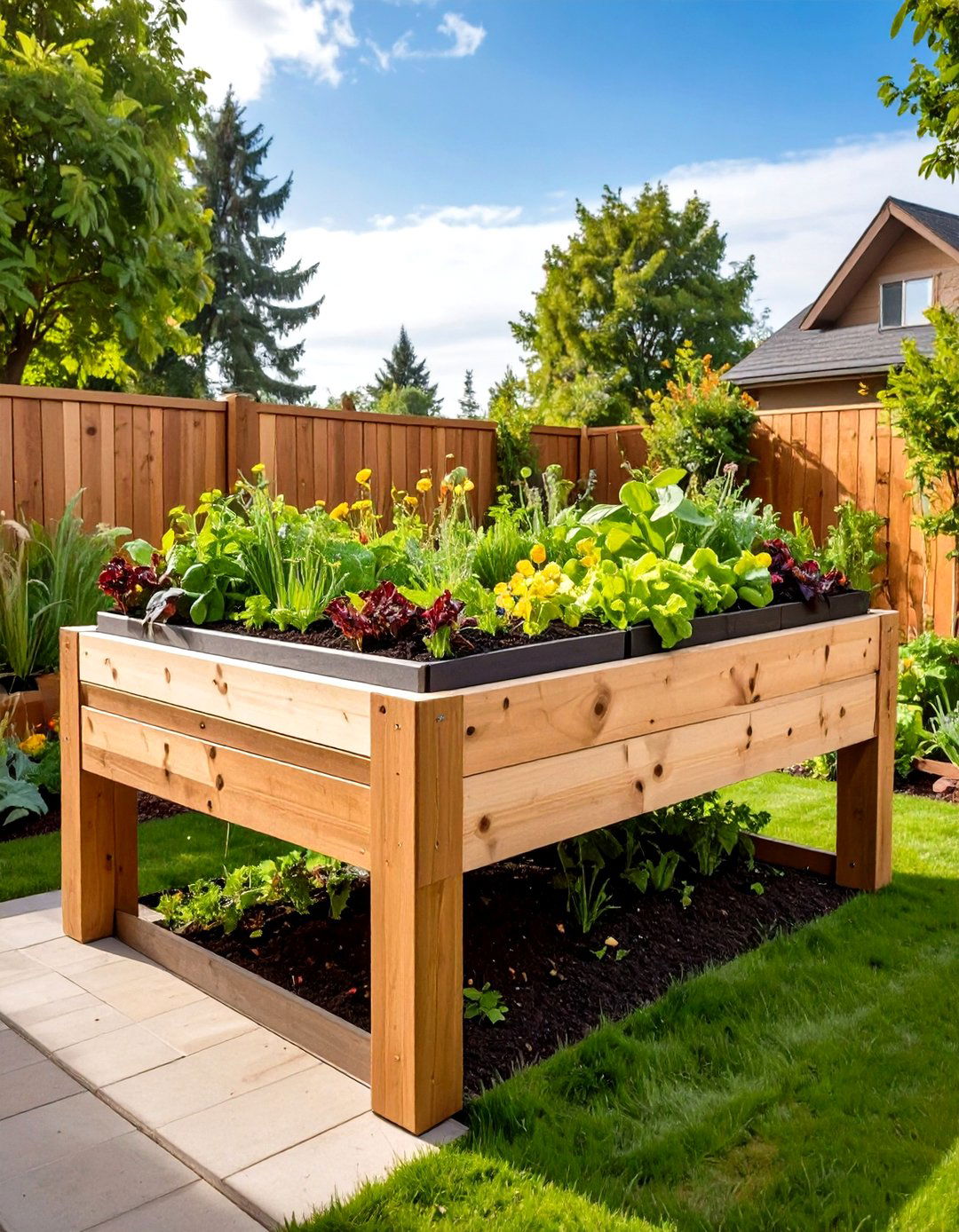
Create accessible, ergonomic growing spaces with elevated table-style raised garden beds along fences that bring gardens to comfortable working height. These structures stand 30-36 inches high with 6-8 inch deep growing beds supported by sturdy wooden or metal frames. The elevated design eliminates bending and kneeling, making gardening accessible for people with mobility limitations or back problems. The table height works particularly well for herb gardens and salad crops that require frequent harvesting. The elevated position also provides better drainage and air circulation while protecting plants from ground-dwelling pests. Storage shelves can be integrated beneath the growing surface for tools and supplies. This design works exceptionally well in small urban gardens where space is limited but accessibility is important. The elevated approach creates attractive garden features while providing practical growing solutions for various physical abilities.
Conclusion:
Raised garden beds along fences offer endless possibilities for creating productive, beautiful garden spaces that maximize limited yard areas while enhancing landscape design. These versatile structures accommodate various gardening styles, from rustic cottage gardens to sleek modern installations, while providing improved growing conditions and easier maintenance. Whether choosing natural materials like cedar and stone or contemporary options like galvanized steel and composite lumber, fence-adjacent raised beds transform ordinary boundaries into thriving garden features. The key to success lies in selecting designs that complement existing fence styles while meeting specific gardening needs and accessibility requirements. With proper planning and construction, these garden beds provide years of productive growing while adding value and beauty to any outdoor space.


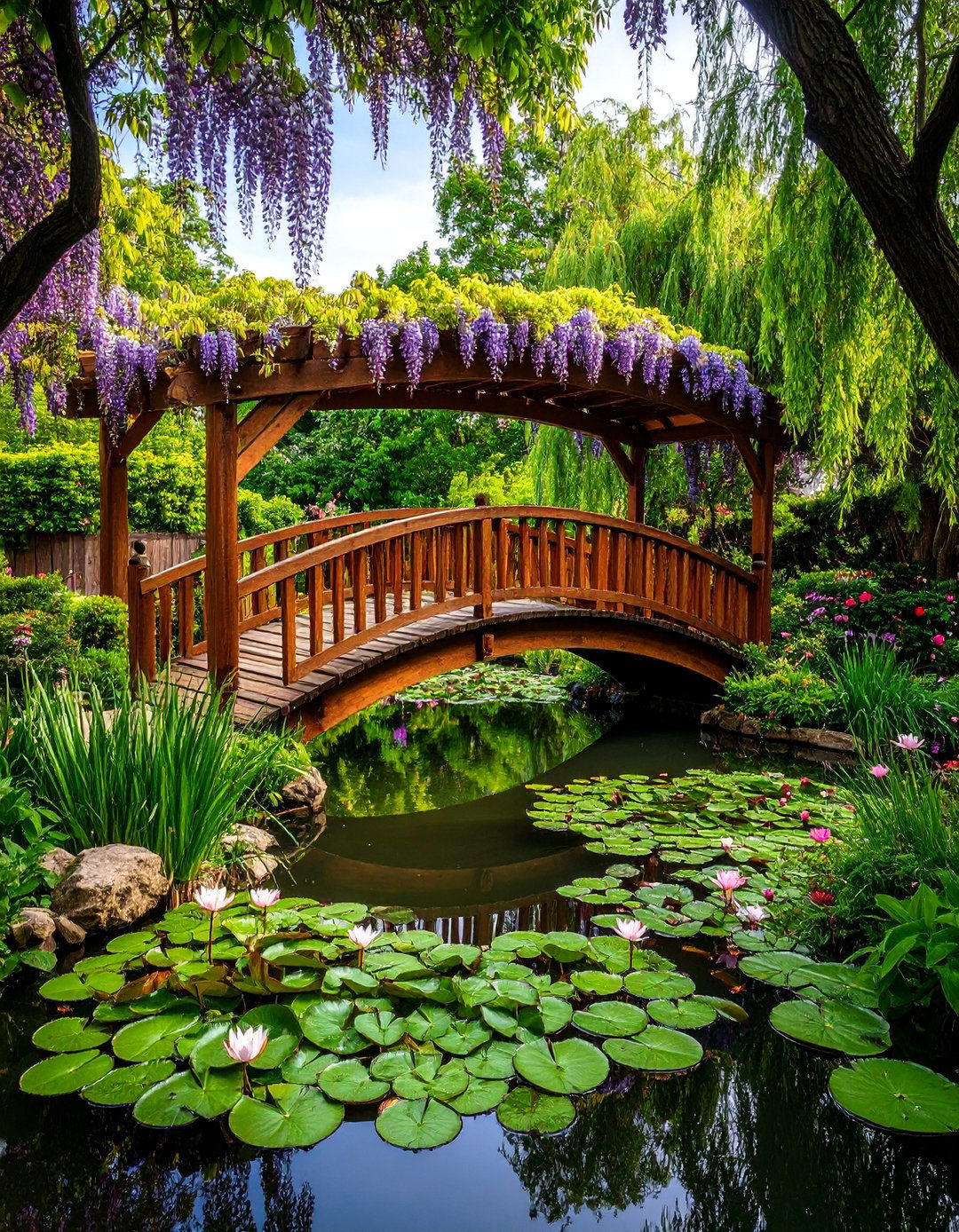
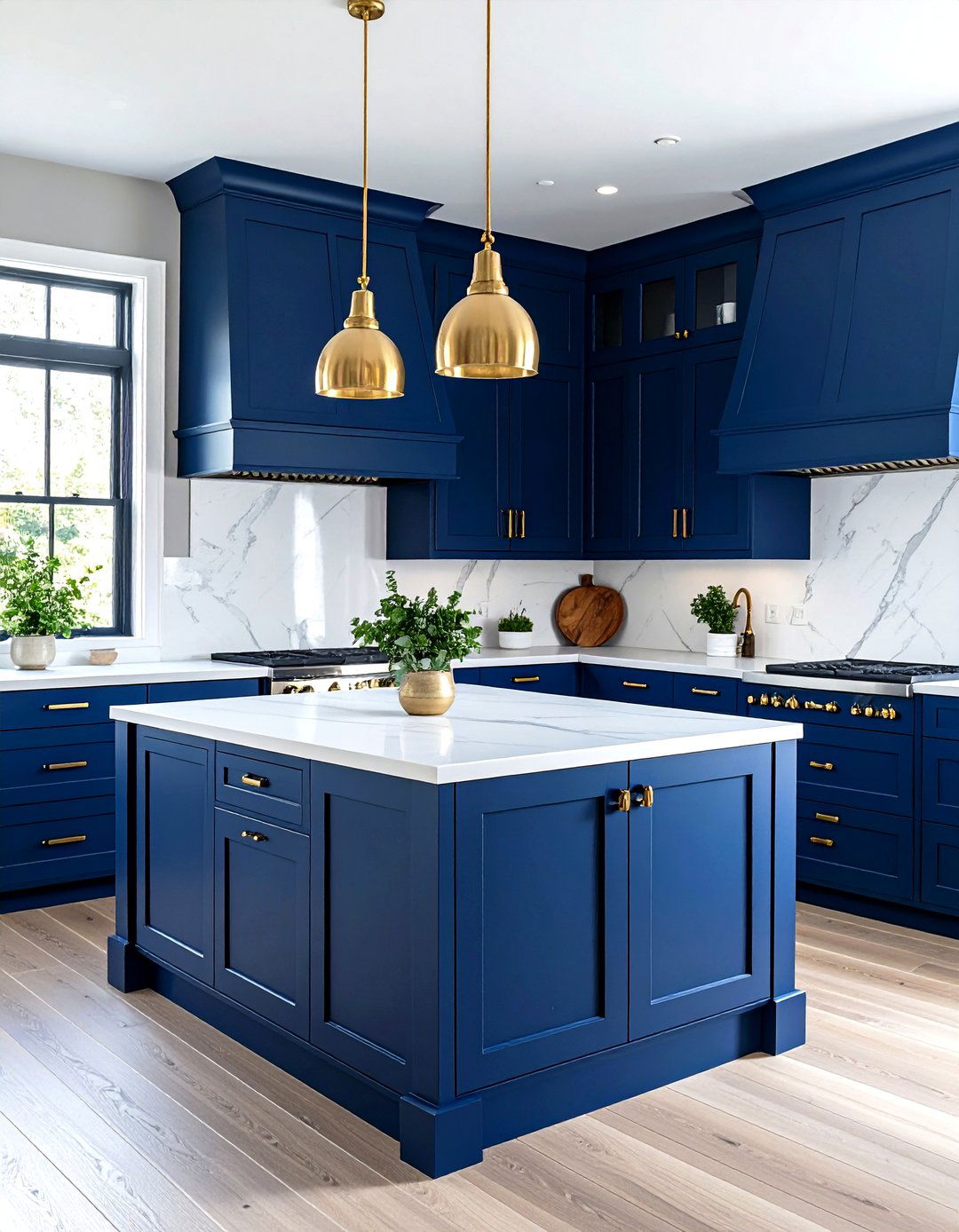
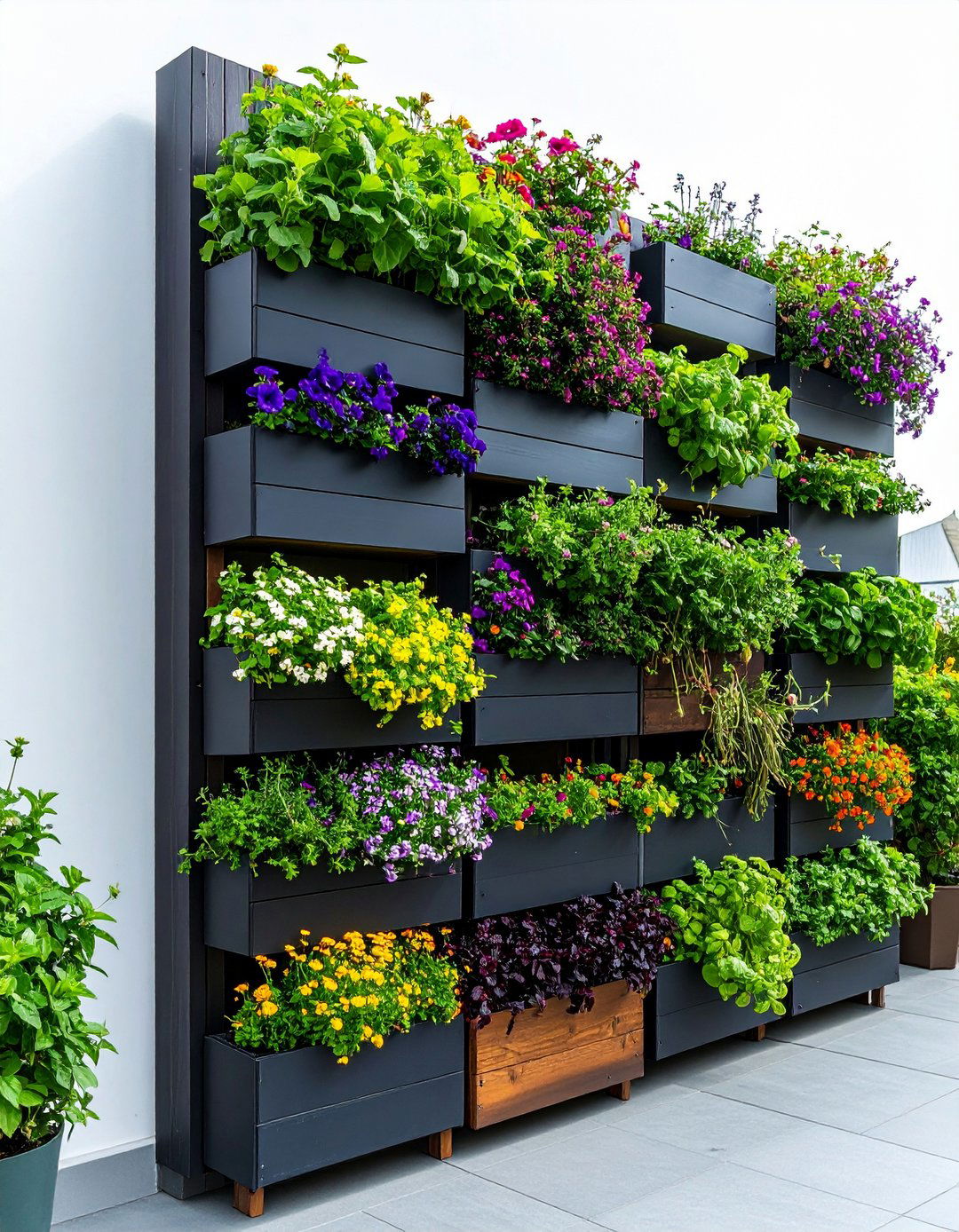
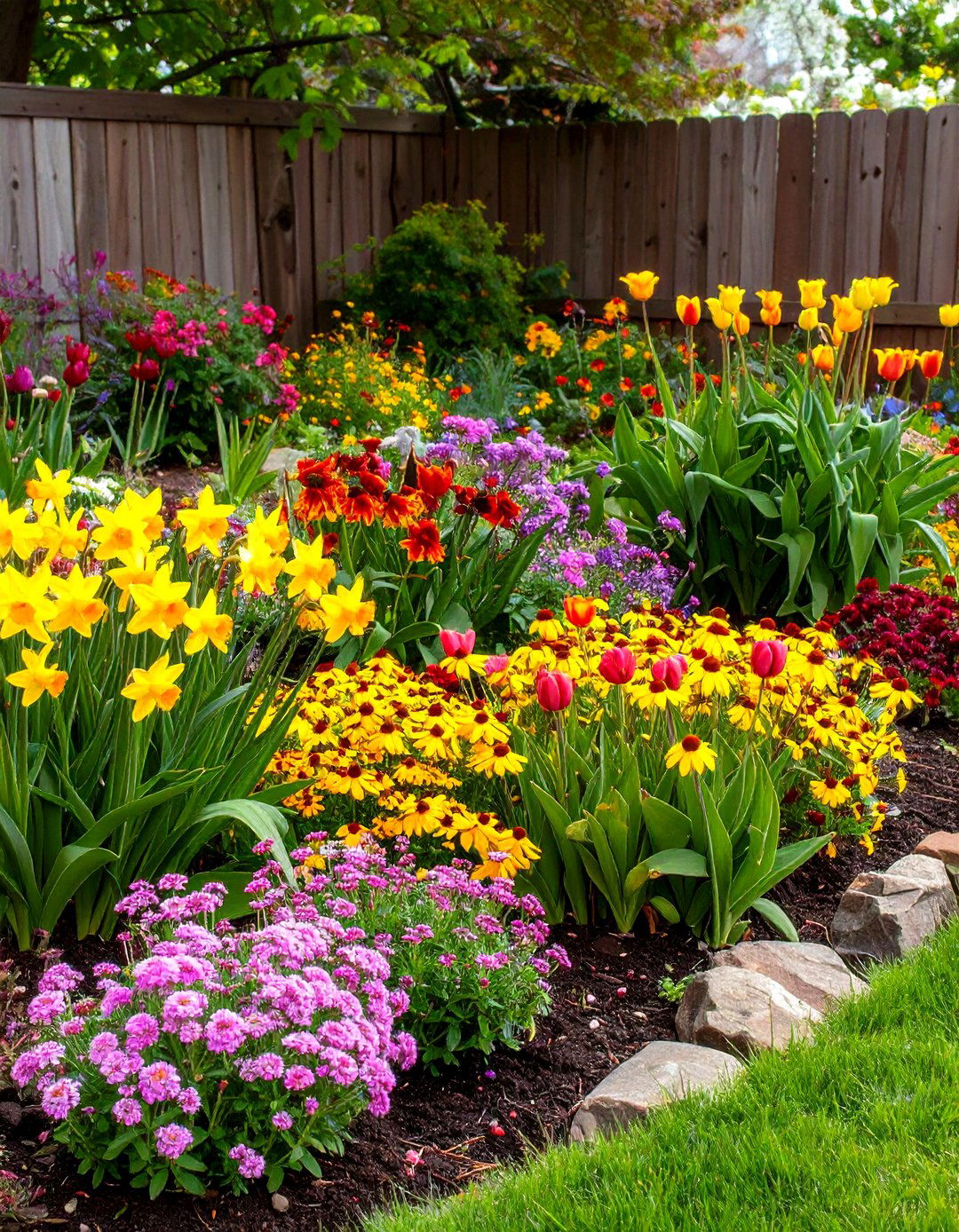
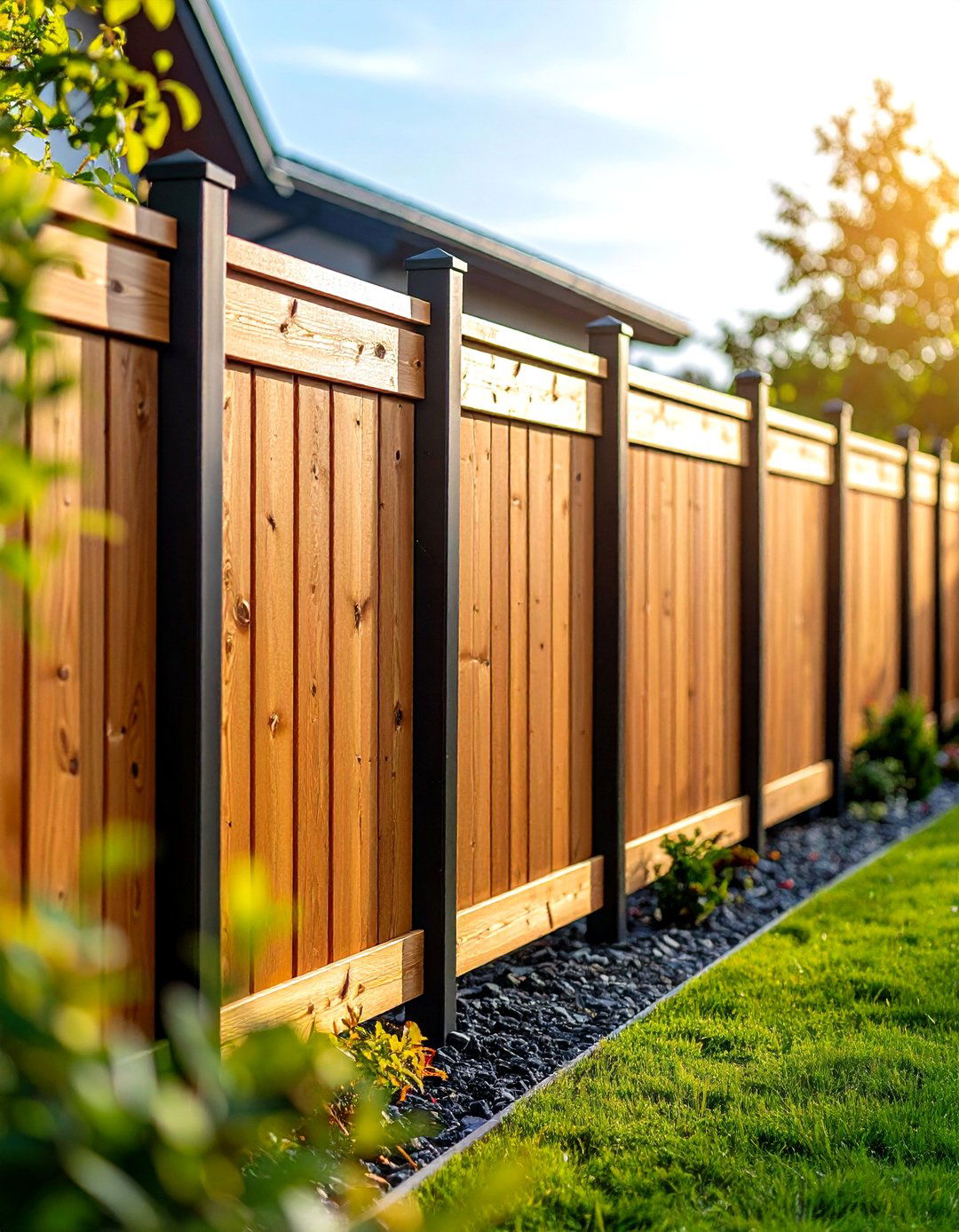
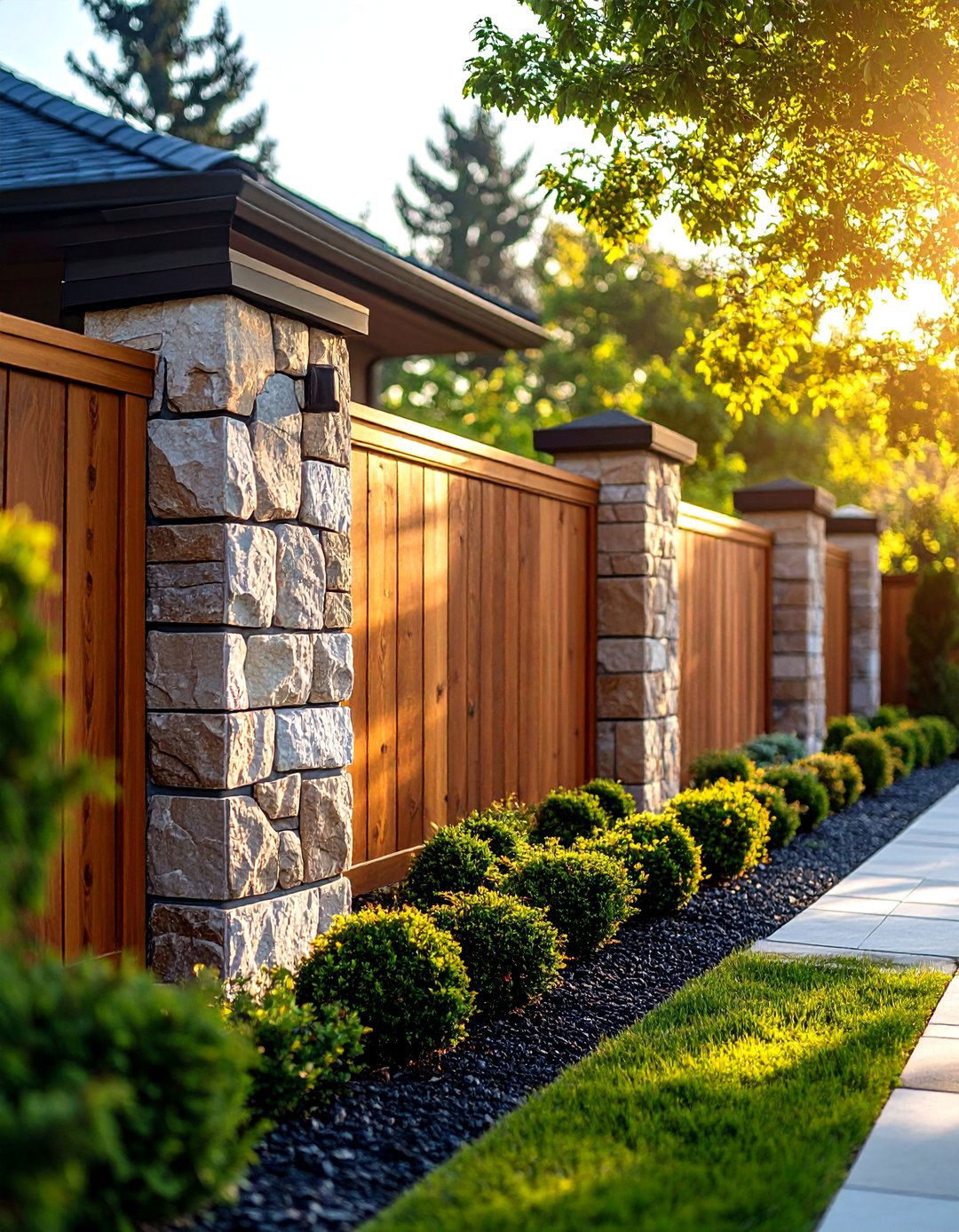

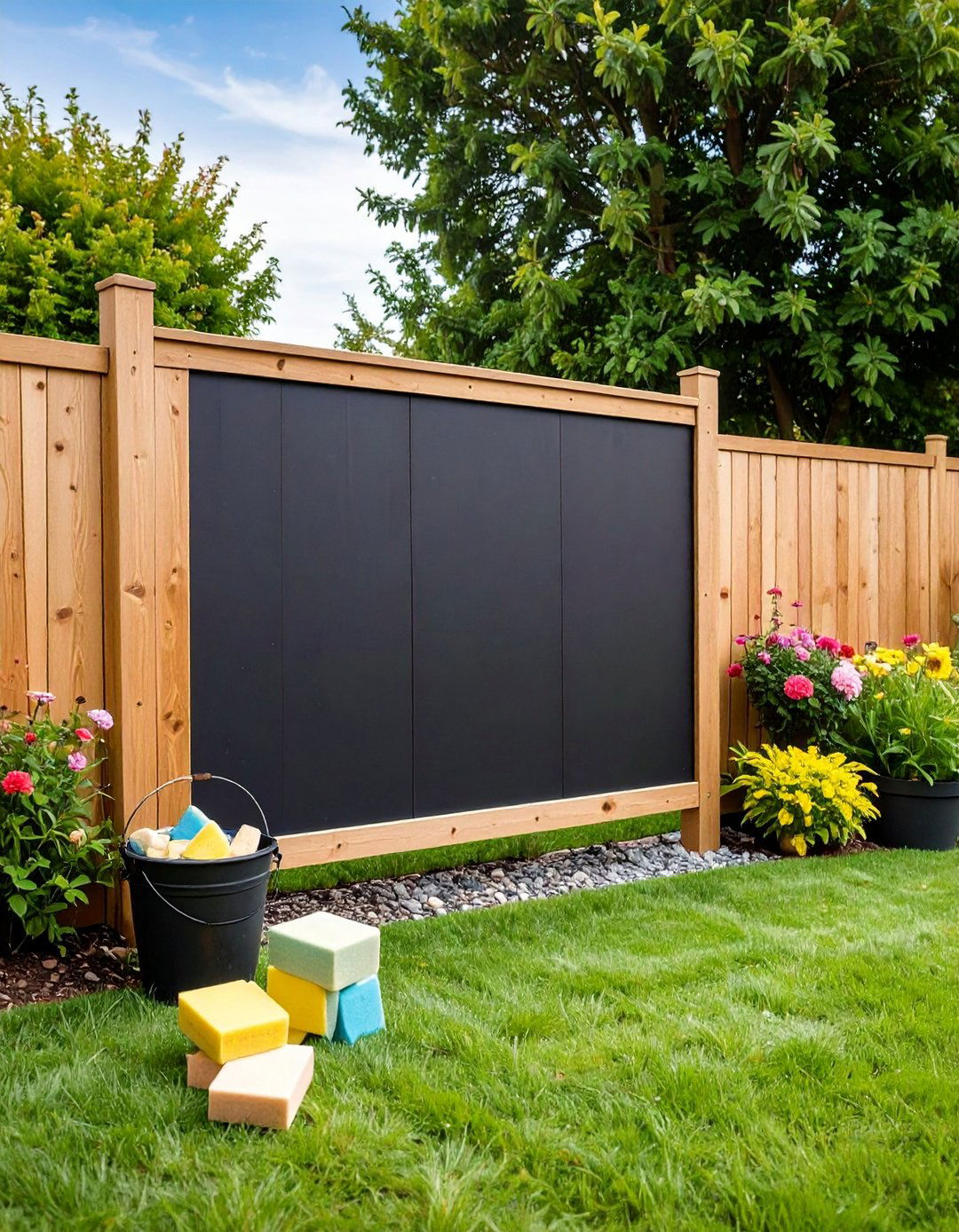
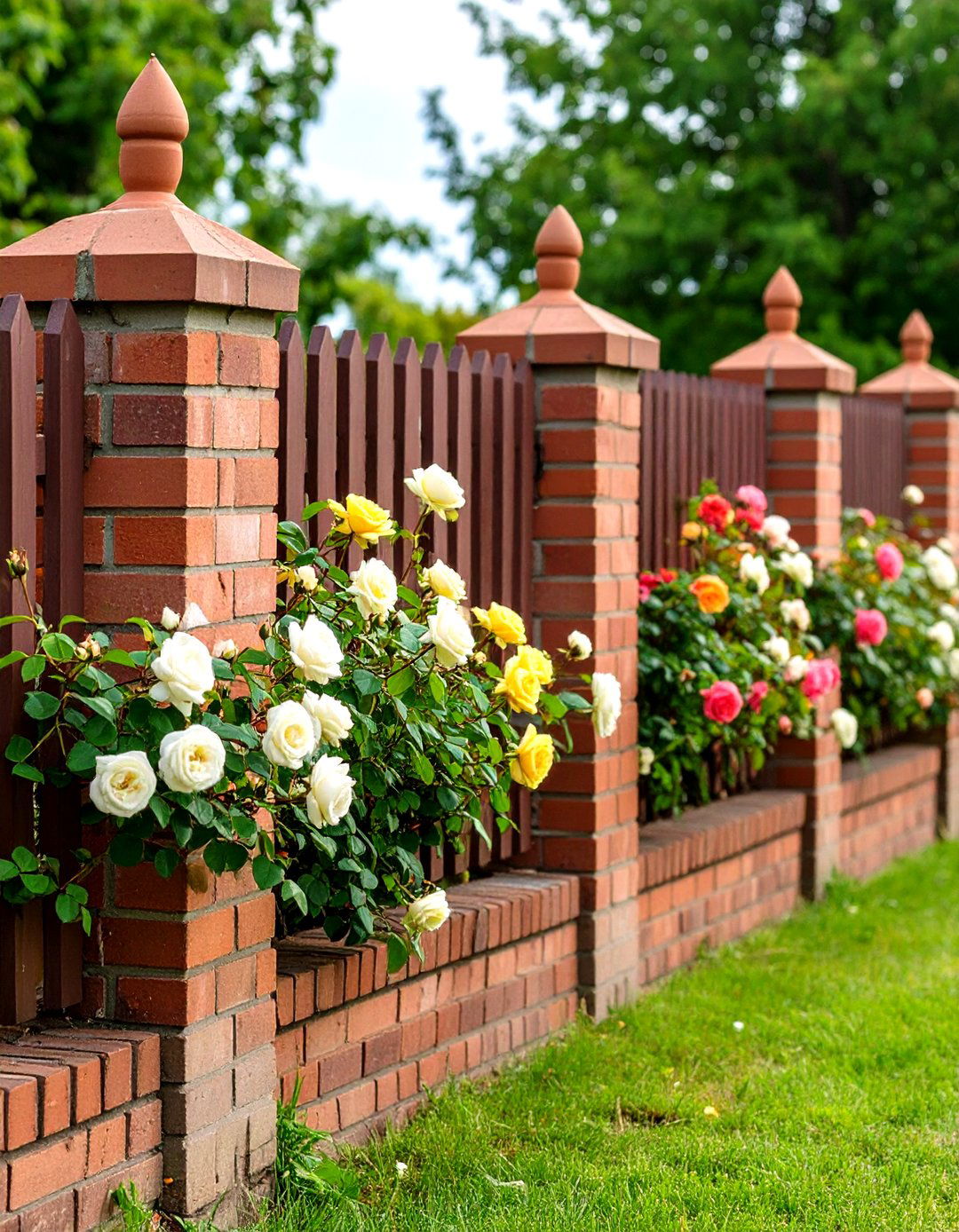
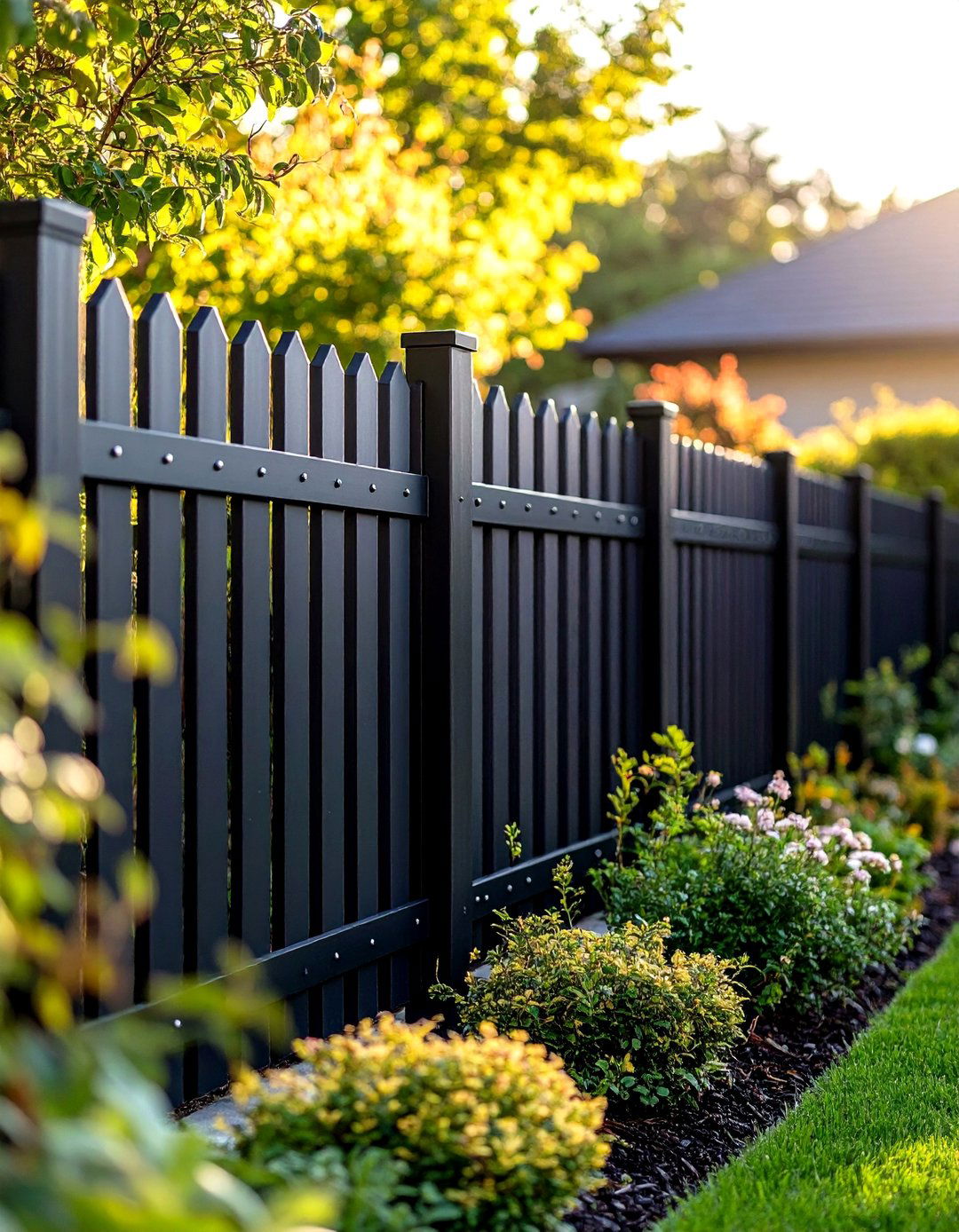
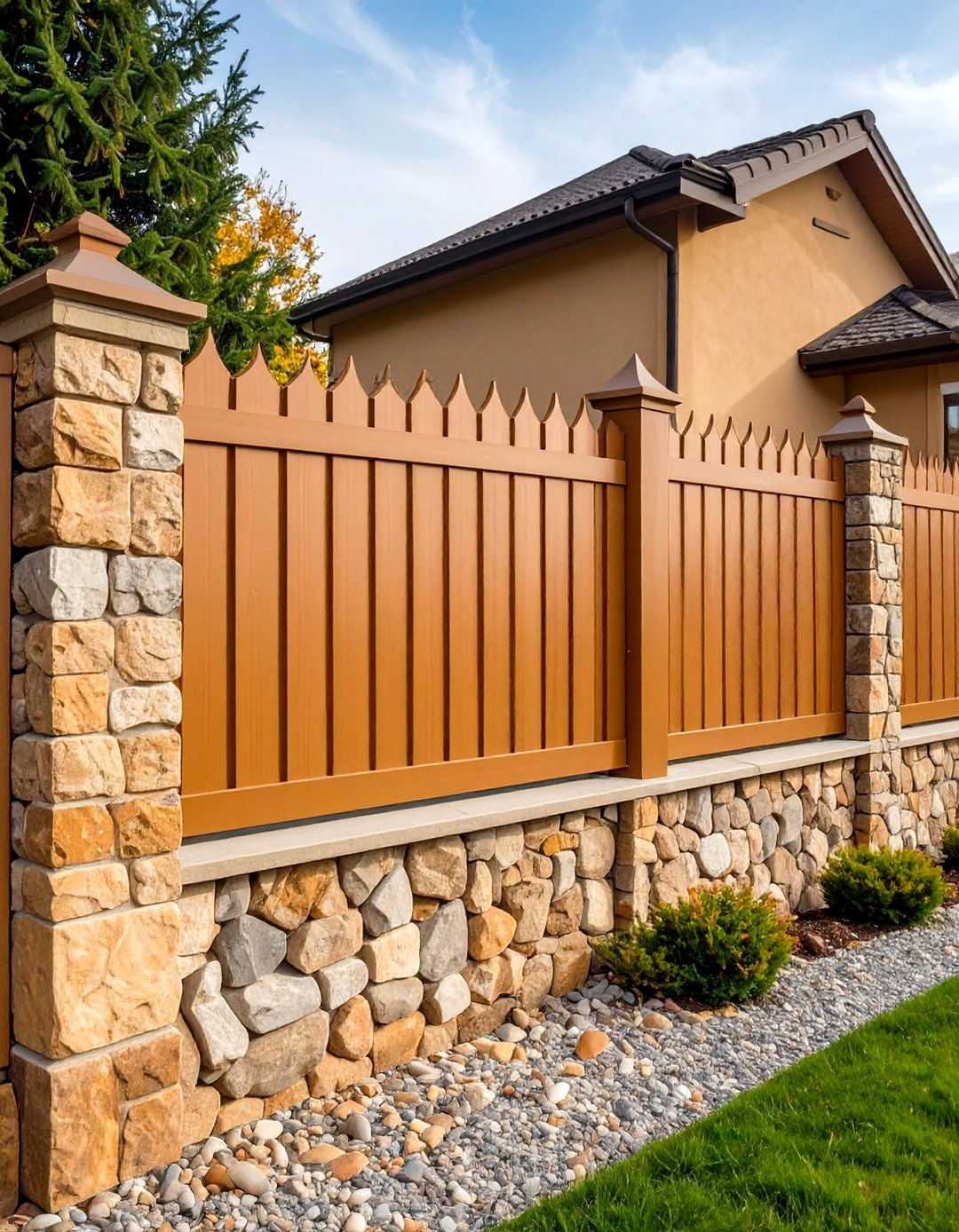
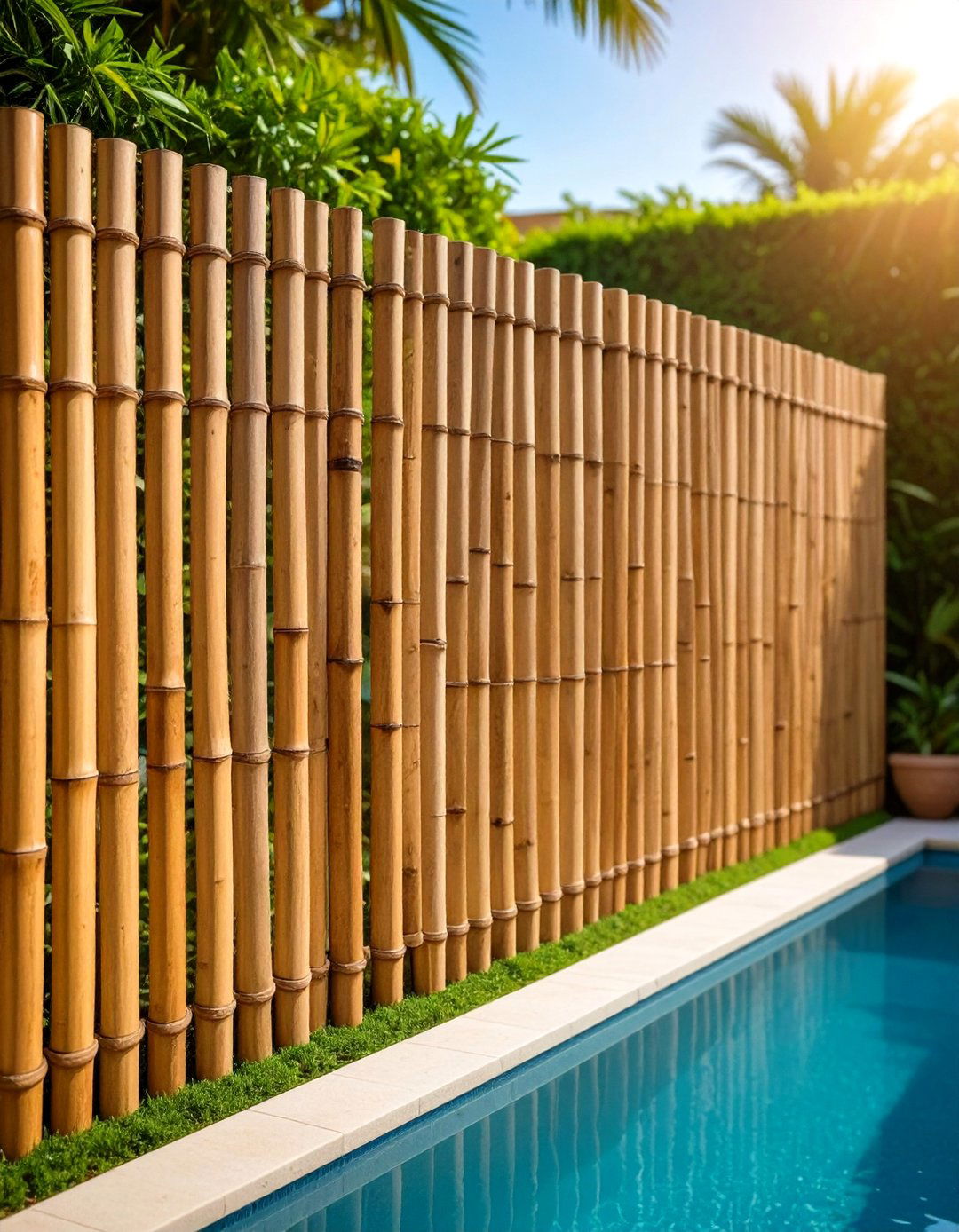


Leave a Reply